The Diesel trains F7 Sign measures 10″ x 12″ by artist, Daniel Edwards. The 9 Western American railroad F7 diesels are the Western Pacific, Santa Fe, Southern Pacific, Union Pacific, Rio Grande, Missouri Pacific, Great Northern, Northern Pacific, and Chicago Northwestern. Decorate your train room walls with more signs from our great selection.
More information about F7’s from Trains.com :
The Diesel Locomotives F-7 Sign is 10″ x 12″ by artist, Daniel Edwards. The 9 Western American railroad F-7 diesels are the Western Pacific, Santa Fe, Southern Pacific, Union Pacific, Rio Grande, Missouri Pacific, Great Northern, Northern Pacific, and Chicago Northwestern.
More information about F7’s from Trains.com :
“COVERED WAGONS.” “CARBODY UNITS.” “STREAMLINERS.” “F UNITS.” Call ’em what you will, when you’re talking the F-for-freight series from General Motors’ Electro-Motive Division, you’re talking the most famous diesel in railroading.Maybe “F” should stand for Face. It’s the famous “bulldog nose” that did it. It hit the road with FT demonstrator quartet 103, “the diesel that did it”-i.e., sealed the steam locomotive’s doom with its 1939-40 coast-to-coast 83,764-mile, 20-railroad, 35-state tour.
Credit Leland A. Knickerbocker, the Santa Fe Railway, and Lionel Corp. for a lot of that fame, too. Knickerbocker’s Warbonnet and Santa Fe’s high Hollywood profile, coupled with the postwar toy-train boom, made the carrier’s passenger F3’s and F7’s the leaders of the F-unit brigade.
The entire F series encompassed eight models from the first production FT of 1940 (for Santa Fe, but in freight blue and yellow) to the last FL9 for New Haven in 1960. The count doesn’t include booster units (“B” units, those without control cabs), and any good model railroader or veteran diesel-spotter will tell you there are several “phases” (carbody styles/ internal details) of most of those F types. After the designation “FT,” the builder went with chronology through 9 on the F’s (some numbers were on passenger E units only).
Hands down the largest F-series seller was the F7, which – like its predecessor, the F3 – was rated at 1500 hp. (There was an F5 model – late F3’s in F7 carbodies and with new D27 traction motors, but the builder did not publicly apply the designation.) The F7 sold 3,849 units (2,366 A’s, 1,483 B’s) in North America during 1949-1953, the height of the dieselization of American railroads.
In U.S. diesel history, only two other models, both also EMD, the GP9 and the SD40-2 have outsold the F7. Totals for each of the F groups: FT, 1,096; F2, 104; F3, 1,807; F7, 4,221 (including 372 FP7’s); and F9, 384 (including 83 FP9 and 60 FL9 versions).
An old saw is that it’s easier to name the major railroads that did not buy F’s than to try to remember all that did. Among those that didn’t were Alco stalwarts Ann Arbor, Delaware & Hudson, Green Bay & Western, Lehigh & New England, and Tennessee Central; and some late-to-dieselize roads, mostly coal-haulers that skipped freight carbody units and went right to hoods: Illinois Central, Nickel Plate, Norfolk & Western, and Virginian (yeah, we know, Illinois Central [Gulf] and N&W inherited F’s in mergers and repainted a few). Then there’s the Long Island Rail Road – in the glory days, the only cab diesels it had were by Fairbanks-Morse, but later it employed rebuilt FL9’s.
EMD’s F’s were everywhere. More than 75 North American railroads, from Alaska through Canada into Mexico, wound up with them, and 50 roads bought F7’s new. The largest F7 fleets were Southern Pacific’s (530) and Santa Fe’s (472), although the latter was in a sense two fleets, the Warbonnet red/silver passenger or dual-service units and the blue/yellow freight fleet. New York Central had 293 F7’s, Baltimore & Ohio 257, Pennsylvania 199, Chesapeake & Ohio 148, Southern 147, Milwaukee 118, Great Northern 108, Chicago & North Western 106, and Wabash 105. At the other end of the spectrum were “small and obscure” F7 owners Charleston & Western Carolina; Kansas, Oklahoma & Gulf; Texas-Mexican; and Illinois Terminal.
Like all early diesels, the F7’s were swept aside by newer types, and by the 1980’s most any fan who cared could recite the pockets of active ones, including U.S. Steel’s Atlantic City Mine railroad in Wyoming; Louisiana & North West; Kansas City Southern; and Bessemer & Lake Erie. Many F7’s were rebuilt, some into modernized cab units for commuter agencies (Boston and Maryland), or hood units (Santa Fe’s famous CF7 fleet), or “power cars” for the opposite end of commuter trains (Long Island, GO Transit). Some survived as “executive” units for business trains (North Western and Clinchfield-cum-CSX). Burlington Northern retired its F9AB set to the Illinois Railway Museum but KCS still powers its “Southern Belle” business train with ex-Canadian FP9’s.
Excluding such curiosities, it’s generally accepted that the era of EMD F units in regular everyday freight service for U.S. common carriers ended October 13, 1992, with the B&LE F7’s on subsidiary Western Allegheny in Pennsylvania. The qualifying categories are necessary because, until the mines closed, F9’s continued to haul iron ore for LTV (formerly Erie Mining) in northern Minnesota.
Want to ride behind an F7? Go north. You can still do so in regular service on Alaska Railroad (one F7B) and Connecticut’s Metro-North diesel-powered branches, as well as behind first-cousin FP7’s on Ontario Northland [November 1994 TRAINS] and Montreal commuter trains, plus younger sibling FP9’s on Algoma Central and Canadian Pacific’s restored luxury train the Royal Canadian Pacific.
Restored F7’s from other sources painted to represent Lehigh Valley and Monon (it had only F3’s) pull occasional excursions in New Jersey and Indiana. Dinner trains in Kentucky, Minnesota, and Washington employ F’s, as do a few freight short lines and tourist carriers. Some museums run their F’s, and at least three dozen F’s, about half of them F7’s, are preserved privately or as park displays in more than 20 states plus Canada and Mexico.
Any way you look at it, Diesel Trains F7 is a face no railroader or rail enthusiast will ever forget. See our other signs to give as gifts or decorate your man cave walls.

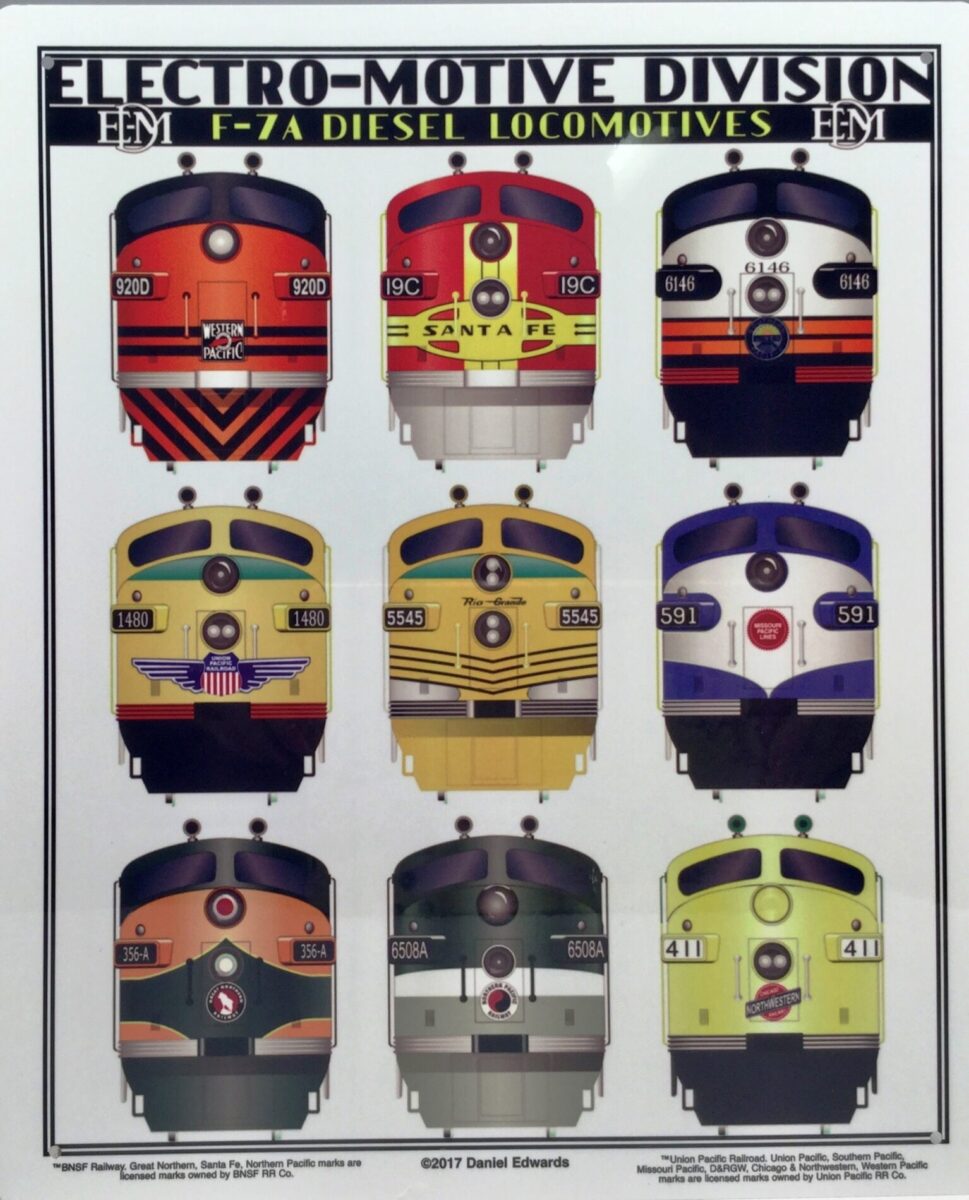
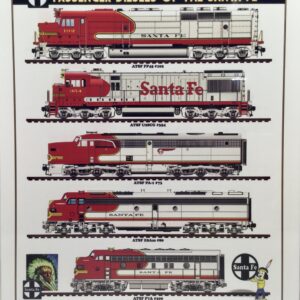
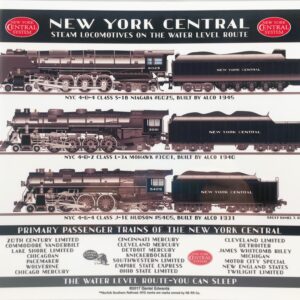
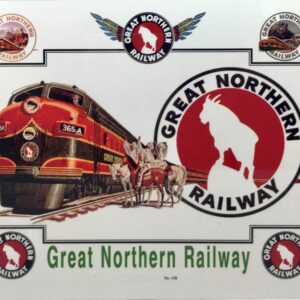
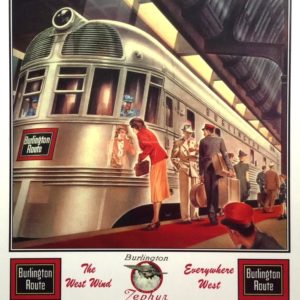
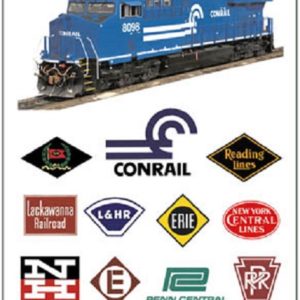
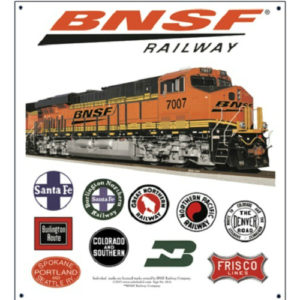
Reviews
There are no reviews yet.